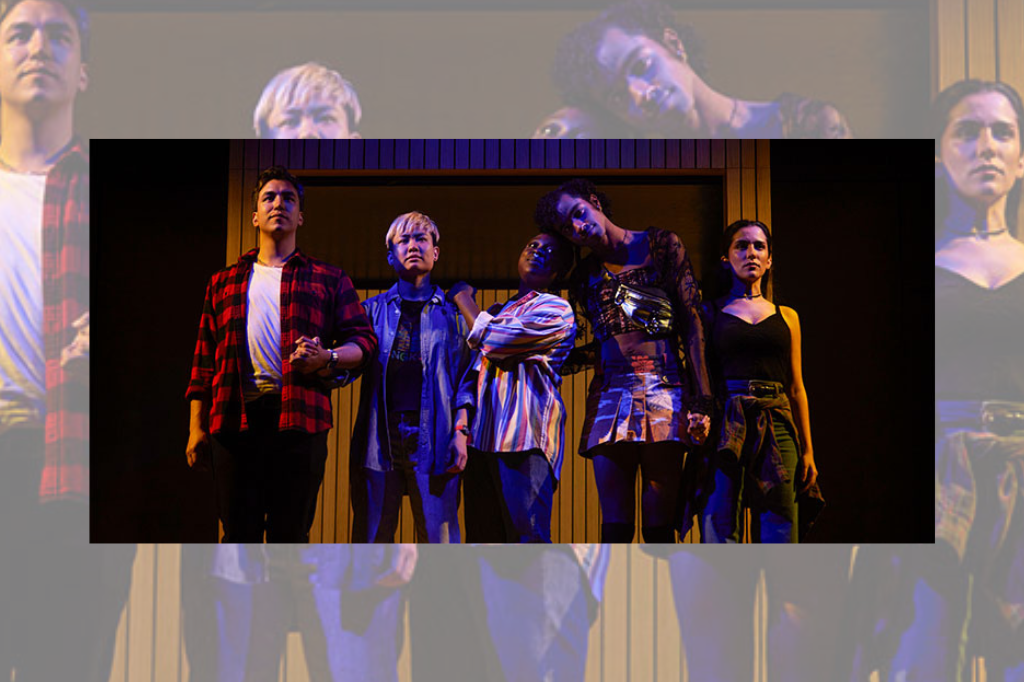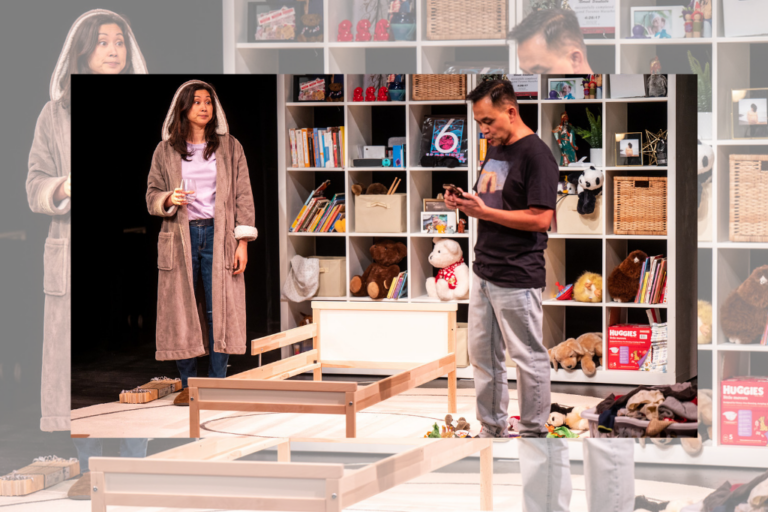REVIEW: Every Little Nookie at Stratford Festival
The following review is a conversation between Intermission senior editor Aisling Murphy, theatre critic Karen Fricker, and theatre scholar Michelle MacArthur. Aisling, Karen, and Michelle attended Every Little Nookie together on Tuesday, July 12, 2022.
The following is a transcription of the conversation, which took place in a Stratford Airbnb hot tub immediately following the performance. The transcript has been edited for length and clarity.
Karen Fricker: So in the spirit of critical polyamory, we’re here in a hot tub in Stratford. For real. Having a discussion about Sunny Drake’s Every Little Nookie.
Aisling Murphy: And normally it’s just you and me in these critical conversations, Karen, but we have a guest!
Michelle MacArthur: Hi, I’m Michelle MacArthur. I’m an associate professor of Drama at the University of Windsor and the editor of the play collection Voices of a Generation: Three Millennial Plays. Thank you for letting me into your crouple — your critical throuple — to discuss this play.
AM: As is only appropriate.
KF: Why don’t we start by each giving a sentence or two, just setting up what the play actually is. Let’s start with you, Aly.
AM: Oh, wow. Sure. An exploration of millennial malaise through sex?
MM: I’d add that it’s an intergenerational exploration of sex, and an attempt to bridge generational gaps or misunderstandings.
KF: It’s a world premiere comedy at the Stratford Festival and the first show of the year in the Studio Theatre. It’s healthily budgeted, excitingly designed, and long.
AM: I’m curious for you both, what did you know about Every Little Nookie beforehand?
MM: I knew it was about swinging, and by Sunny Drake.
KF: I knew about the intergenerational aspect, and I knew that some of the performers in it are new to Stratford, such as Khadijah Roberts-Abdullah and Stephen Jackman-Torkoff. I’m excited by the fact there’s a lot of new talent at Stratford this season. And they delivered for me, as did the whole cast. I thought Every Little Nookie was really, really well acted.
AM: This year’s my first Stratford Festival. Has Stratford programming ever been this — I guess “daring” is the right word? I was surprised, knowing very little he
ading into the play, that for this rather elderly audience, we were diving (or swinging) into the world of polyamory.
MM: I think about Bunny by Hannah Moscovitch, which was also a very frank exploration of sexuality, especially for the Stratford stage.
KF: Another show that explored sexuality in that frank, thrilling way was Bakkhai, in the old Tom Patterson Theatre. I mean, it’s interesting you’re surprised by this one, Aly — what did you find daring about it?
AM: I can’t think of too many plays about polyamory, full stop — and this is a play about the relationships implied by polyamorousness, not just featuring them. So for a Stratford crowd, that surprised me, and maybe challenges what are perhaps my prejudices against more senior audiences moving forward.
There’s also 100% more boob in this show than I’ve seen in any other play while I’ve been in Canada.
KF: I found it interesting that the audience seemed to really enjoy it, and there were very few walkouts. It’s a long play with an intermission, so people had the opportunity to leave if the story wasn’t jiving with them. But pretty much everybody stayed.
MM: I think there’s things here that make it work for the Stratford audience. The first is that this conversation about polyamory isn’t really new. It’s been unfolding in the cultural zeitgeist for quite some time, on television shows like The Politician and Schitt’s Creek and all over reality TV. So in a way, the topic didn’t seem that edgy to me and I wondered if the Stratford audience felt the same. But the play also reminds us that polyamory itself is not new. Older generations — including those represented in the audience — experimented with it in the ‘60s and ‘70s (and of course long before then).
I think, too, the audience can appreciate the exploration of sexuality in older adults. I feel like the audience tonight really resonated with that, some of the commentary on marriage and what happens to sexuality and intimacy over time. I think that’s maybe what made it less risky than Bunny.
KF: When I think about Bunny, at Stratford and Tarragon Theatre, and now having taught it at Brock University, edginess emerges in the sexual contact between the professor and student — that’s where controversy comes in with that play.
Every Little Nookie is very much pro-sex, pro-play, pro-poly, pro-exploration. It’s also fairly high-comedy. I wouldn’t say it’s slapstick, but there’s physical comedy; jokey, quick dialogue exchanges; and a really fun slide in the middle of the set. It seems like there’s a spirit of playfulness as a way to draw in an audience.
AM: I also think, perhaps retracting my earlier point — it’s not necessarily about sex. It’s using sex as a manifestation of relationships. But I find it’s much more about connections with people, how those ebb and flow, how sex can either intensify or alienate a relationship.
MM: Totally, and that seems to be the message we got during the land and family acknowledgment before the show. Two of the actors start the performance with an explanation of this idea of chosen family, reiterating that the themes in Every Little Nookie are somehow beyond sex positivity. It’s more how we make families and how that connects to broader social structures like government and economics.
KF: It’s at this point I do feel a desire to articulate the plot. There’s a nuclear family in the play in the form of an older couple Margaret (Marian Adler) and Kenneth (John Koensgen) and their mid-30s adopted daughter Annabel (Rose Tuong). She has a chosen family of bohemian pals. She has a partner, Grace (Roberts-Abdullah), and then Grace has another partner, Smash (Jackman-Torkoff). Is that a throuple?
AM: That dynamic tends to be called a hinge relationship. There’s a person at the apex of the V — they’re the hinge — and then romantic partners on either side. In the play, the group also includes a sex worker character, Crystal (Verónica Hortigüela), but she’s not really intimate with any of them. She says she’s monogamous with a boyfriend we never meet.
KF: And she’s an academic. And so the premise is that Smash, who is non-binary, throws swinger parties, and apparently those have recently been in Annabel’s parents’ house while they’ve been at the cottage.
AM: Yeah, a lot of that context is established pretty early on. The parents have a massive house with separate rooms for all the activities of the swinger parties — it seems like there are endless rooms. And that winds up being extremely important to the resolution of the play, spoiler alert.
KF: It’s fairly classic comedy. Exposition, inciting incident, et cetera. Mom and Dad come home, and they walk in on the party. And there aren’t a massive number of negative consequences for that.
AM: No, it’s all fine pretty quickly, eh?
KF: Margaret is intrigued. And the plot kind of spirals out from there.
AM: Margaret’s intrigue also results in a weaving-together of the two generations. For me, that felt fast. But it also meant we got to the interesting bit quicker, so I’m torn: the transition felt awkward for me, but I was also suddenly interested in what would happen next.
KF: What was that interesting part you were excited about?
AM: I think it was seeing the complications of making polyamory work outside of a sexual arrangement. I was interested in the conversations around time management and jealousy. I became much more invested in the concept of the play when it stopped trying to tell me that polyamory can work, and when it started being a vessel for asking what happens when it doesn’t. That’s a more interesting play for me.
KF: Oh, and speaking of quick, Annabel gets a straight boyfriend, Matt (Richard Lam) in a hot second who’s a single dad. That arrangement felt a little contrived — so quickly do we have the heterosexual single parent experience represented.
AM: Well, right, and that’s another commentary on what makes a family, right? It’s another iteration of “this is what family can be,” which to me also felt a little contrived. I liked the play, but my issue with it was generally how easily solutions to complicated problems emerge.
MM: Right? Annabel’s found the best cis straight guy, and he’s right on board from the beginning with her being dominant in the bedroom. And then he’s totally into the polyamory. And then he’s very flexible with parenting.
KF: I really liked Richard Lam in the role. I found him likeable. But I agree with you both about the character — he felt like a bunch of affirmations without much binding them together.
AM: There are so many moments in the play where you feel like the arrangement is going to go pear-shaped. And those are the moments where I’m interested, those precipices of high drama and stakes. But then they’re squashed pretty quickly. A risky phone call is a declaration of love, which feels surprisingly fast.
KF: In some of the depictions of the younger group, I found their manners of speech a bit performative, playing “young.” Some of their expressions didn’t always seem entirely plausible.
AM: There’s this episode of The Office which is sort of legendary in its own right, called “Dinner Party.” One of the running jokes is how often two of the main characters call each other “babe.” And it’s funny because it’s weird — no one says “babe” at the end of every sentence like that. And I felt that a little here, these oddly placed terms of endearment at the ends of lines. I almost wished those had been improvised — “hon” felt old-fashioned and at odds with the characters saying it, and the repetition of “babe” wasn’t much better.
KF: Yeah, the use of “hon” when Crystal bonds with Kenneth — I didn’t buy it.
MM: That part of the plot almost felt like a PSA made for a Stratford audience, talking down to them about what young people are like and thinking about, about their sexual preferences and politics. “Here’s Polyamory 101, brought to you by caricatures of Millennials.” This bothered me a little, because I think it wasn’t giving the older audience enough credit. They understood: many Boomers came of age during the sexual revolution, so their experiences weren’t that different. And I felt like the plot with the parents, the older generation, was a bit more compelling, and written in a more realistic way. There was a difference in style.
AM: So that’s one of my sticking points, actually. The younger group is articulated to be early to mid-thirties, but they felt like my generation — for context, I’m 24. The mannerisms mirrored those I and my friends have. This felt a little as if it were written by someone just removed from what younger folks are saying and doing at the moment. Or, Drake’s making a comment that life really just doesn’t get any better or distinguishable from your mid-twenties onwards. I’m more inclined to believe the former.
MM: I have a question. So Smash kind of parodies the Manic Pixie Dream Girl stereotype, and invokes that explicitly. But does the character actually challenge the stereotype? I was thinking about the relationships between the generations, and the younger generation is really helping Margaret get in touch with her desire and reconnect with her husband. But what is the older generation offering to the younger one? What does Smash get in the end? Acceptance into the chosen family, I guess.
AM: But that’s the bare minimum, right? The group really seems to use Smash as it suits them. It feels like a transactional relationship.
KF: In the second act of the play, we’re taken in some unexpected and, frankly, kind of bonkers directions. And in some of it, I was like, “great! Let’s go bonkers!” But when it comes to Smash, I just didn’t understand why their friends rejected them. The character becomes homeless. Why did their friends betray the character who had sort of been their sugar daddy? And in the second act, we get into this whole conversation about socialism and politics. Why?
AM: Yeah. Let’s talk about cooperative housing. Not for you, though, Smash, we’re mad at you.
MM: And then that’s solved very quickly too. The parents jump in and solve the housing crisis. Smash can stay in the house.
KF: And meanwhile, Smash is forging something of a service role with the mom character. I didn’t know what we were supposed to be making of that.
AM: Well, and let’s talk about the pregnancy, as well. It’s a major plot device. To me that felt like one of the more earned twists of the play. But again, it’s wrapped up remarkably quickly. The single dad has extra room and an existing kid who really wants a sibling. Done. It’s an interesting problem but solved much too quickly for my liking.
KF: Things get resolved like an old-fashioned comedy.
AM: So, yes, but the old-fashioned structure and the contemporary subject matter, for me, didn’t really gel. The form and the content diverge, without necessarily commenting on each other.
KF: What performances, or moments, or production elements would you like to highlight? Anything you found particularly successful?
AM: I mean, it’s the slide. I adore the slide designed by Michelle Tracey. In the week following seeing the show, I’ve dreamt about the slide. It’s a neat little metaphor for how things snowball out of control, the effort needed to climb out of those problems. There’s some really interesting staging from ted witzel, and it keeps it interesting.
MM: Right? Is it a sex slide instead of a sex swing? Is the sex slide the new sex swing?
AM: In this world, these people are sliders, not swingers.
KF: A convention of the play is that there are a lot of overlapping scenes, two dialogues going on at the same time. How was that working for y’all?
AM: This is a taste thing where I think Michelle and I likely disagree. Go ahead, Michelle.
MM: I think it’s hard to make that work. Often it forces the director to have to resort to tableaux, where actors who aren’t speaking are freezing. And there were some really virtuosic freezes in the show — at one point one of the characters is literally holding another character in the air. But it can also make for some awkward staging. It’s hard to keep up the pace that the play needs, the energy needed to go back and forth like that.
AM: I felt at times they kept it up, and when they got into those rhythms I really loved the play. I wish they’d managed to sustain that pacing. I was reminded so much of Brad Fraser’s Love and Human Remains, which in the productions I’ve seen has proven to be a masterful work when the production can figure out the pacing.
I did appreciate here that we saw sex mostly in tableaux — there’s very little simulated sex, and lots of tableaux interspersed between changing vignttes. It’s a seductive little play when the gears fit together — but I often found myself more in a state of wishing for those moments of synergy than actually relishing in them.
MM: You know what, I think you’re right. Those moments — when Margaret and her lover Phoenix (Roberts King) and Kenneth are switching back and forth between scenes. That was seamlessly directed and I thought it made a lot of sense dramaturgically.
KF: In terms of Aria Evans’s intimacy choreography and movement direction, there was enough time and resources to do that very well. Those moments of choreography were wow moments, and the intimacy felt very maturely handled.
MM: And I think it’s important to say that the one moment of nudity in the show is with Marian Adler’s Margaret. And it’s a glorious and proud moment. I think that’s important. Absolutely a good choice and a pointed statement on aging bodies onstage.
KF: I really enjoyed the performances from Adler and Koensgen. At the beginning of the play, I thought we were slightly in restoration comedy territory in terms of the heightened level of performance, but they found a solid level. I was most interested in them and their journeys and their relationship. I wonder if that’s what other audience members went home talking about.
AM: Yeah, I mean that’s also the most complete of the relationships we see, right? We enter with them at a kind of stasis, and we finish with them at a stasis. We see the younger group go through all these configurations and never quite land on solid ground — the older couple, for their exploration, both begins and ends in relatively stable spots. It feels like a complete arc. It’s interesting, because you almost have two separate plays running in succession, and it feels as if they’ve been woven together after they were both finished.
MM: The story that’s interesting here is the older couple, and the sexual reawakening that we don’t usually talk about. But we don’t really talk about older adults’ sexuality and intimacy, and what happens when you’ve been married for 30 or 40 years.
KF: I think also, particularly in the second half of the play, it goes deep into housing and real estate. There are all these mounting incidents where the younger generation is unhoused and desperately needs housing. That feels like another play. And then it all gets fixed at the end.
AM: Yeah, and I feel like that solution is sort of antithesis to the rest of the play — the rich folks clean everything up.
MM: It felt like in that way it was following a traditional comic structure, except that the family that is reinstated in this mommy-and-daddy-to-the-rescue resolution is a chosen one. That’s something I really appreciated–how the play exploded the nuclear family and ultimately queered it.
KF: Any speculation why it needed to be set at Christmas?
AM: I immediately went to Schimmelpfennig’s Winter Solstice, a Christmas play which also has shades of infidelity and transgressive sexual politics.
MM: It made me think of Rent!
KF: Ooh, yes, and its much-critiqued depiction of faux-bohemian-ness. There was some of that here too for me.
I’m thinking a lot about this as a piece of new writing. The Stratford Festival has a new play department, and they’ve devoted a ton of resources to this production. They’ve employed a large and diverse cast — that’s great. But I do feel like it could have used some dramaturgical tightening.
AM: I’m inclined to agree. I did feel the second half of the play got a little bogged down in statistics, and lost some of the drive to explore the characters and relationships.
MM: Right, and there’s so much to explore. I love the PhD student Crystal and what her role says about precarious academic labour and prostitution.
AM: I do wonder if there’s a 100-minute version of this play. She’s a long one.
Did you guys like the play? I’m not sure if I can actually tell.
KF: I think I most enjoyed the performances and the set. And the potential the play provides for conversations such as this one.
AM: I agree. I also think the individual moments in the play are beautifully crafted — and Sunny Drake sure can write a one-liner — but the entire shape of the narrative, the connective tissue between moments, is where it loses me.
MM: I found it very watchable. I was engaged the whole time. I enjoyed observing the audience and noticing what jokes hit them — Margaret’s revelation about lube was a fan favourite. The Dufferin Mall shout-out was my personal fave.
AM: It’s so sex-positive, and it doesn’t pick and choose what it’s sex-positive about. It’s generally celebratory. Every Little Nookie, even when it loses focus, never loses its joy.
Every Little Nookie runs at the Stratford Festival through October 1. Tickets are available here.

















Comments